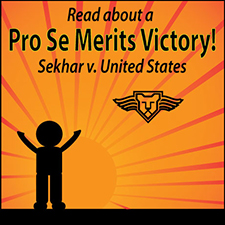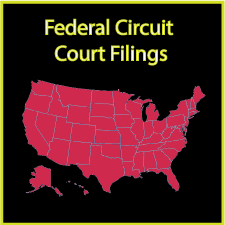Petition of the Month: Edward Lewis Tobinick, M.D. et al. v. Steven Novella, M.D. et al.
The Supreme Court Press “Petition of the Month”TM for October 2017 is Edward Lewis Tobinick, M.D. et al. v. Steven Novella, M.D. et al., Supreme Court Dkt. No. 17-344, an appeal coming out of the Eleventh Circuit. The Tobinick petition was filed by attorney Cullin O'Brien of Cullin O'Brien Law, P.A. of Ft. Lauderdale, Florida. (Note: the Supreme Court Press does not endorse either party in this case)
Questions Presented:
1. When a defendant is sued for both common law defamation and business disparagement under the Lanham Act, 15 U.S.C. § 1125(a)(1)(B), does the application of state civil court anti-SLAPP procedure irreconcilably conflict with Federal Rule of Civil Procedure 56?
2. Is commercial competition a necessary element of whether business disparagement is actionable “commercial advertising or promotion” under the Lanham Act, 15 U.S.C. § 1125(a)(1)(B), in light of this Court’s definitive holding that commercial competition is not a requirement for standing to sue under the Lanham Act in Lexmark Int’l v. Static Control Component, 134 S.Ct. 1377, 1392-1395 (2014)?
3. In a Federal Rule of Civil Procedure 56 summary judgment analysis of whether business disparagement is actionable “commercial speech” under the Lanham Act, 15 U.S.C. § 1125(a)(1)(B), is a court required to consider the “full context” of how the defendant is disseminating the disparagement, including the defendant’s secondary and for-profit uses of the disparagement?


Thank you for discussing the Tobinick case with us. This is a fascinating case – one that would not be possible without 21st century business models that allow individuals to drive Internet traffic by publishing caustic, sensationalistic material. However, the published statements here are not typical salacious stories or celebrity gossip. Here, an Internet entrepreneur, defendant Dr. Steven Novella, who is also a practicing neurologist, made allegedly false statements about Dr. Tobinick, the Institute of Neurological Recovery, and their medical practice. Can you provide a high level overview of the case? |
|
 |
This is a case about whether a defendant can be held liable under the Lanham Act for the false commercial disparagement of a medical practice, when that defendant has the twin goals of preventing the public from accessing the medical practice and of monetizing Internet traffic from the disparagement. Dr. Novella made a series of false disparaging statements about Dr. Tobinick and the Institute of Neurological Recovery (“INR®”) on the Internet. The courts below held that the First Amendment provides immunity for the disparagement, and, without even getting into whether many of the statements were false, dismissed the case at the summary judgment stage. Dr. Tobinick and the INR seek review by the United States Supreme Court because they strongly believe that the Lanham Act was designed to protect U.S. businesses from the type of false commercial disparagement at issue in this case. |
Let’s go to the background of what appears to be a war between two specialties: neurology and internal medicine. |
|
 |
You are exactly right – this dispute reflects an underlying turf war between two medical specialties that have different patented drug treatments for the same medical disorders. Etanercept is a biotechnology drug originally used by Internal Medicine and Dermatology specialists to treat arthritis and psoriasis. Dr. Tobinick made the surprising discovery that etanercept, administered by a novel method, could be used to treat certain previously intractable neurology disorders. Dr. Tobinick published his findings in peer-reviewed medical journals. The INR internal medicine physicians then began treating these patients, thereby “invading the turf” of practicing neurologists, like Dr. Novella. |
Now let’s discuss Dr. Novella’s background. Why does Dr. Novella have an interest in making the challenged statements about Dr. Tobinick, the INR and their medical practice? |
|
 |
Dr. Tobinick and the INR found during discovery that Dr. Novella takes a substantial monthly salary from his Internet production company, SGU Productions LLC (“SGU”). Dr. Novella’s statements about Dr. Tobinick and the INR were used to attract consumers to the SGU Productions LLC (“SGU”) website and its advertisements, solicitations, and products for sale. What may not be readily apparent to readers of SGU publications is that SGU is a for-profit company and Dr. Novella is an Internet entrepreneur. Dr. Novella spends considerable time each week as the owner and director of SGU, which sells merchandise on its Internet store (including pens and t-shirts) and sells to the public monthly subscriptions to its podcasts and “premium content”. It is a lucrative business. During this lawsuit, Dr. Tobinick and the INR uncovered evidence that Dr. Novella “monetized” his SGU website and Facebook pages by using them to “funnel” Internet traffic to SGU, whose webpages, podcasts and Internet store solicited the public to purchase paid SGU subscriptions and merchandise. |
Did Dr. Novella cease publishing the alleged attacks against Dr. Tobinick and the INR after the lawsuit began? |
|
 |
No, he did not. Instead, Dr. Novella published additional false attacks during the litigation, using SGU webpages and an SGU podcast (SGU Podcast 472). Among other attacks, Dr. Novella falsely characterized Dr. Tobinick and the INR as a “one-man institute” engaged in “Health Fraud” through a “quack” and “dubious clinic”; misleadingly implied that Dr. Tobinick’s patents were unethical; and mischaracterized Dr. Tobinick’s medical education as lacking “formal training” in neurology. |

Is there a distinction between scientific criticsm as part of an academic or medical debate versus criticisms that can be commercialized? |
|
 |
Yes. Attacks against staffing, patents, pricing, etc., all of which were at issue here, are not elements of a scientific dispute or debate. Rather they are elements of a commercial attack and exactly why the Lanham Act should be the appropriate vehicle for redressing the harm. |
In the course of amending your complaint, the District Court hit you with a Snafu. The Court ruled that California procedures trumped federal procedures, dismissing the case under the California anti-SLAPP statute. Can you describe what happened? |
|
 |
This case presents the circuit conflict about whether state court anti-SLAPP procedure are proper in federal court. Here, because Dr. Tobinick had defamation claims, Dr. Novella, who is a Connecticut defendant, invoked the California anti-SLAPP procedure in Florida federal court. Ultimately, the invocation and application of the anti-SLAPP procedure during the case had the adverse result of the district court and the Eleventh Circuit refusing to consider all of the admissible record evidence in deciding summary judgment. It is settled law that courts must consider all of the admissible record evidence in deciding summary judgment under Rule 56. Yet the anti-SLAPP procedure had the effect of overruling Rule 56 and caused a decision that did not reflect a substantial amount of admissible record evidence, including expert evidence. Dr. Tobinick and the INR maintain that had all of the material admissible record evidence been considered (including SGU Podcast 472, which both parties had stipulated to earlier in the case), Dr. Tobinick and the INR would not have been dismissed at summary judgment. For example, the Eleventh Circuit found that Dr. Novella could have been engaging in actionable “commercial speech” under the Lanham Act if his Internet attacks were inside of commercial “windows.” Yet the very admissible record evidence the Eleventh Circuit refused to consider as a result of the California anti-SLAPP procedure were Novella’s attacks inside of commercial SGU “windows.” It should also be emphasized that the operative complaint encompassed the content of the SGU website and Dr. Novella’s SGU podcasts, which are part of the admissible record evidence the courts refused to consider in their summary adjudication. |
The Eleventh Circuit Court of Appeals also implied that the case did not qualify for Lanham Act scrutiny because Dr. Novella and Dr. Tobinick were not competitors. Dr. Novella challenged whether competition was ever addressed by the circuit. Can you describe how you believe the Eleventh Circuit touched on competition? |
|
 |
The Eleventh Circuit held that competition is required to state actionable false advertising under the Lanham Act. The Eleventh Circuit went on to find that Dr. Novella treats headaches and Dr. Tobinick and the Institute of Neurological Recovery do not. That is factually incorrect – Dr. Tobinick and the Institute of Neurological Recovery treat headaches, and there was sworn admitted evidence showing this, but more importantly, this requirement of “competition” conflicts with the Supreme Court’s decision in Lexmark Int’l v. Static Control Components. Lexmark definitively holds that plaintiffs have standing to sue non-competitors under the Lanham Act. Thus, the Eleventh Circuit’s competitor requirement for establishing false advertising liability under the Lanham Act resurrects something that the Lexmark case definitively put to rest. The Fourth and Sixth Circuits have each recently looked at this same issue and have found that Lexmark eliminates any competitor requirement for establishing false advertising liability. Thus, there is a circuit split at issue. And the problem is that the Eleventh Circuit did not cite nor mention Lexmark anywhere in its opinion. |
Why do you believe this case is important for the Supreme Court to consider? |
|
 |
If the Eleventh Circuit is correct, then a business has no recourse against a non-competitor for false disparagement under the Lanham Act. While Lexmark gives the business standing to sue, the Eleventh Circuit’s position is that the business would ultimately lose the case without being able to establish “commercial advertising or promotion” through a showing of “commercial competition.” Without definitive clarity from the US Supreme Court on whether a showing of competition is required, there will be considerable confusion among courts and litigants as to whether a Lanham Act plaintiff can sue a non-competitor and how to apply Lexmark. This confusion could embolden an increase in false commercial disparagement due to the ease with which purported “non-competitors” can use the Internet for false business disparagement. |
 If the Eleventh Circuit is correct, then a business has no recourse against a non-competitor for false disparagement under the Lanham Act. While Lexmark gives the business standing to sue, the Eleventh Circuit’s position is that the business would ultimately lose the case without being able to establish “commercial advertising or promotion” through a showing of “commercial competition.” Without definitive clarity from the US Supreme Court on whether a showing of competition is required, there will be considerable confusion among courts and litigants as to whether a Lanham Act plaintiff can sue a non-competitor and how to apply Lexmark.
If the Eleventh Circuit is correct, then a business has no recourse against a non-competitor for false disparagement under the Lanham Act. While Lexmark gives the business standing to sue, the Eleventh Circuit’s position is that the business would ultimately lose the case without being able to establish “commercial advertising or promotion” through a showing of “commercial competition.” Without definitive clarity from the US Supreme Court on whether a showing of competition is required, there will be considerable confusion among courts and litigants as to whether a Lanham Act plaintiff can sue a non-competitor and how to apply Lexmark.

---Bryan-Krumm.png)
---ZoeSpencer.png)


